Photos with this report (click to enlarge) | |||
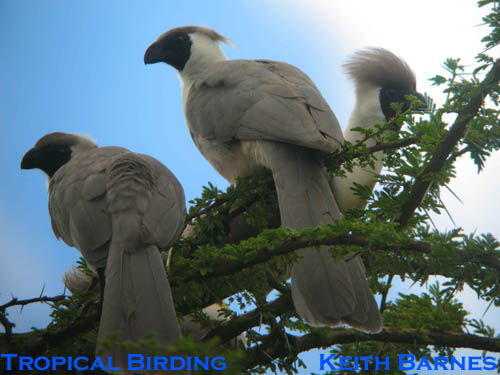 Bare-faced Go-Away Bird |
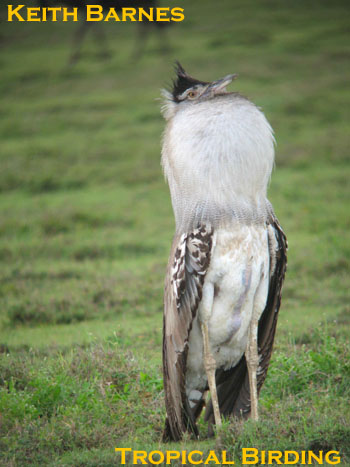 Kori Bustard |
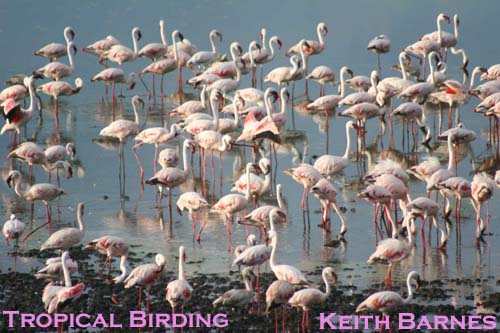 Greater Flamingo |
|
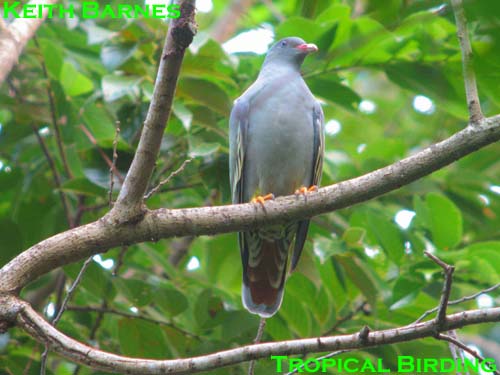 Pemba Green Pigeon |
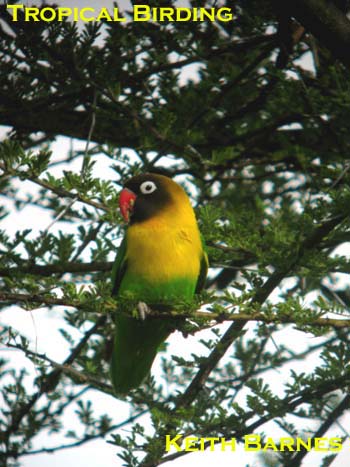 Yellow-collared Lovebird |
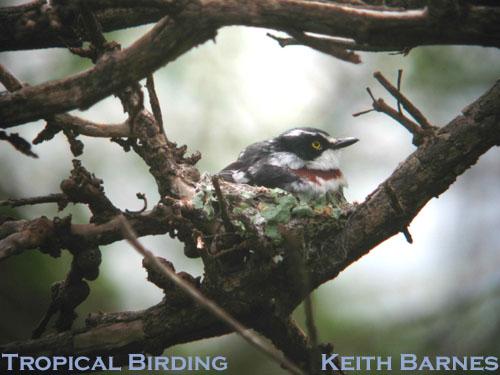 Black-headed Batis |
|
See www.tropicalbirding.com for more details on this trip as a set-departure or custom tour
Summary
As usual, northern Tanzania was an extravaganza of birding set against the wildest and some of the most unique of Africa’s backdrops, Arusha NP, Mkomazi, the Usambara Mountains, Pemba Island, the expansive Serengeti and Ngorongoro Crater. As a wilderness experience, the mammals of northern Tanzania are hard to beat. Amongst the mammal highlights two leopard, as well as omnipresent lion prides and many species of ungulates amongst the 58 mammal species encountered! The birding yielded a 516 species. Birding highlights included some of Africa’s most endangered birds, the Critically Endangered and recently recognised Beesley’s Spike-heeled Lark and the equally enigmatic Moreau’s Tailorbird of the East Usambara Mountains. We also were overawed by most incredible birds in superb plumage including long-tailed whydahs and widowbirds, spectacular bishops and weavers in full breeding plumage. Bustards were strutting their stuff in full display, as were the larks doing their aerial acrobatics. We also nailed the Karamoja Apalis at the recently discovered stake out in the Serengeti. Although the birding was sensational and the predators impressive it was hard to top driving through what seemed like endless herds of grazing wildebeest and zebras that just seemed to go on forever in the Ndutu plains area. On this trip the birding was brilliant in the most spectacular wildlife show on earth!
Daily Log
5 Apr: Arusha
We started the trip with some leisurely birding around Arusha where we quickly notched up a few specialties including breeding Taveta Golden Weaver and Grey-Olive Greenbul amongst the more spectacular Silvery-cheeked Hornbill, and an immaculate pair of Brown-breasted Barbets as well as a secretive nestbuilding Peter’s Twinspot. The afternoon session yielded Long-tailed Fiscal and hoardes of Red-tailed and Lesser Grey Shirkes moving through on passage en-route to the Palearctic.
6-7 Apr: Moshi – Mkomazi G.R.
For the next couple of days we were to bird the drier scrubland around the town of Same and spent some time in a mobile camping safari in the Mkomazi Game Reserve. This is fantastic birding as seeing things is easy and the birds are spectacular. We enjoyed gems such as Blue-headed Cordon Blue, Purple Granadier, Hilderbrandt’s Starling, Eastern Chanting Goshawk, Hunter’s and Beautiful Sunbird, Temminck’s Courser, Red-fronted Warbler, Long-crested Eagle and many more. The following day in Mkomazi highlights included Red-bellied Parrot and a superb series of displaying Zanzibar Red Bishop, White-winged Widowbird and Fire-crowned Bishop. A lake en-route to the Usambaras yielded 20 of the regionally uncommon Spur-winged Plover, Pink-backed Pelican, African Openbill and Hottentot Teal. That evening we heard Wood Owl and Barn Owl in the forest near the lodge.
8-9 Apr: West Usambaras
Birding a variety of forest patches in the West Usambaras yielded excellent results. The birding was slow (as Afromontane birding often is) but we managed to reel off the local Usambara specialities and high altitude species over the next two days. We started with Eastern (Usambara) Double-collared Sunbird, Moustached Green Tinkerbird and White-eyed Slaty Flycatcher. Some birds took more time and we eventually got looks at Bar-tailed Trogon, Scaly-throated Honeyguide, Olive (Usambara) Thrush, Mountain Buzzard, Black-headed Apalis, Usambara Weaver, Yellow-throated Woodland Warbler, White-starred Robin, Black-fronted Bush Shrike, White-tailed Crested Flycatcher, African Hill Babbler, Short-tailed Batis, and the gorgeous Hartlaub’s Turaco showed itself, although often fleetingly. We spent some time on the forest floor looking for secretive understorey birds. Although it was tough we eventually scored with an Olive Woodpecker and Usambara Akalat. The bizarre, localised and anomalous African Tailorbird was seen regularly while in this area. With their closest relatives in Asia, this is a real evolutionary throwback!
10-12 Apr: East Usambaras
The forests yielded many Silvery-cheeked and Trumpeter Hornbills calling overhead and before long we lucked onto a magnificent Fasciated Snake Eagle that soared overhead for all to admire. Amazingly Banded Green and Amani Sunbirds were seen reasonably well near the village. The following morning started with a bang! At one of the stakeouts a magical single Moreau’s Tailorbird showed well, creeping through the undergrowth. This Critically Endangered species is thought to number less than 50 individuals at this site, although a definitive population of only some 10 individuals is known from Amani!!! Although it is a little grey job, it is indeed one of the star birds of any Tanzania trip. It was misty and good views were hard to obtain, but many of the specialties followed and we saw Green-headed Oriole, Green Barbet, Yellow-streaked and Placid Greenbul, Fisher’s Turaco, Pale Batis and Uluguru Violet-backed Sunbird. White-breasted Alethe and Sharpe’s Akalat’s were both heard and glimpsed, but never gave entirely satisfactory views. The lowlands yielded the magnificent Chestnut-fronted Helmetshrike, Mombassa Woodpecker, Little Yellow Flycatcher, African Crested Flycatcher, Red-tailed Ant-thrush, and Green Tinkerbird. We also caught up with the skulking Kretchmar’s Longbill that perched in the complete open for all to see. The coastal scrub near Muheza revealed Collared Palm Thrush. Lunchtime was spent making a quick sortie to the Tanga harbour….perhaps one of the least impressive visual spectacles on the tour, this collection of rust-buckets did yield some fantastic birds. A rusty floatilla, not more than 2m2 held 10 Crab Plovers, 4 Sooty Gulls and a host of terns including Caspian, Roseate, Common and several Gull-billed terns. We then flew to Pemba Island and settled in at the laid-back beach resort of Manta Reef Lodge. On route we found a beautiful Dickinson’s Kestrel perched next to the roadside.
13-14 Apr. Pemba Island
The birding here was easy and laidback. A welcome change from the days slogging on muddy forest trails looking for skulkers. We enjoyed the two endemics that frequented the hotel grounds Pemba Sunbird and Pemba White-eye. We then headed off to Ngezi Forest where we caught up with the endemic vaughni subspecies of Black-bellied Glossy Starling. After some searching we located a pair of Pemba Green Pigeon’s feeding on a fruiting tree. Later we visited an extremely impressive roosting tree filled with hundreds of the massive endemic rusty-and-black Pemba Flying Fox. We returned to the lodge for lunch. The afternoon was spent at some wetlands finding the exquisite Pygmy Goose, Dimorphic Egret, Mangrove Kingfisher, Palm-nut Vulture and a host of waders. In the evening we ventured back to Ngezi for an attempt at Pemba Scops Owl. Although common, this little bird can be a real troublesome species to find due to their habit of not responding to call and otherwise being decidedly skittish. The night was pretty fruitless and we only got one very brief look, despite the bird being very close on two other occasions. The following morning was spent on a boat, we had good looks at a great tern roost, where we could compare Lesser Crested, Greater Crested, Common and Saunder’s Terns. The trip also yielded a handful of Terek Sandpipers, and some other waders such as Mongolian Plover, our only ones for the trip. We flew, a rather tortuous route back to Arusha, first via Zanzibar, seeing stonetown from the sky and then Dar-es-Salaam, before heading off to Arusha N.P. seeing our first herds of Buffalo and dancing Grey-crowned Cranes serenading us with a delightful dance.
15 April. Arusha NP.
Today we explored some great places in Arusha N.P. including Ngurdoto Crater and the famous flamingo infested Momela Lakes. A spin by the Senato Pools and Lake Longil got things started with great views of a host of waterfowl including our only White-backed Duck of the trip. We enjoyed lunch with Bronze Sunbirds and a spectacular Moustached Warbler and also had great views of White-fronted Bee-eater, another species we were not to see elsewhere. The afternoon got us into the forest where we enjoyed views of both Stripe-cheeked and Eastern Mountain Greenbul, before notching up a cooperative Narina Trogon and within an hour a Brown Woodland Warbler and Black-throated Wattle-eye before we had to head back to our lodge for dinner.
16-17 Apr: Lark Plains and Sinya.
Today we headed to the lark plains were our prize quarry was Beesley’s Lark. We eventually found a small family party of this Critically Endangered bird. Its global population estimated at less then 200 individuals, we were able to watch them forage for some time. Other larks were seen including Fawn-coloured (Foxy) Lark, Fisher’s Finchlark, Rufous-naped Lark, Short-tailed Lark and Somali Short-toed Lark as well as several others. The dry bushland en-route to Kilimanjaro yielded tons of birds including good views at Banded Parisoma, Grey-headed Social Weaver and Red-throated Tit and Red-fronted Barbet. Our ride into Sinya yielded a fantastic male Gerenuk, one of the scarcer antelopes in East Africa. In the late afternoon we enjoyed a walk around Sinya, a spectacular camp on the lower slopes of Kilimanjaro indulging in some final birding before the cloud burnt off and we were treated to magnificent views of Kili from just beneath it! Sinya is a wonderful area and we spent the day soaking up the dryland birds here including excellent views of nesting Grey-headed and African Silverbills as well as Cut-throat Finch using an abandoned Social Weaver nest. A nightdrive was very productive yielded a scarcely seen Striped Hyaena and Springhare before poor roads necessitated a retreat to camp!
18-19 Apr: Tarangire NP & River camp
This area is another fabulous wilderness zone and we were lucky to find a bunch of the most sought-after goodies on arrival including great views of three northern Tanzanian endemics Rufous-tailed Weaver, Ashy Starling and Yellow-collared Lovebird as well as our first Speckle-fronted Weaver. The moister river edges yielded Black Bishop and a staggeringly beautiful male Eastern Paradise Whydah in display, along with the more sombre Steel-blue Whydah. The camp yielded a spectacular Red-and-Yellow Barbet and Grey-hooded Kingfisher.
20-21 Apr. Ngorongoro Crater.
On our journey up the crater rim we screeched to a halt at some flowering Leonotis to be treated to a sunbird spectacle of 20 Golden-winged Sunbirds and a handful of Bronze Sunbirds flitting around and competing with one another for scarce nectar resources. Cinnamon-chested Bee-eaters flitted alongside the cuttings as we ascended the crater rim and we added the dainty White-tailed Blue Flycatcher and Thick-billed Seedeater to our list. In the late afternoon we stopped for views over the crater. This spectacular viewpoint with the floor of Ngorongoro spread beneath us, is indeed an impressive site with animal specks cast out across the crater floor roaming from one good feeding patch to another. We finished off with a Schalow’s Turaco near the hotel. The next day we were up before the rest we enjoyed an almost empty restaurant. While scanning the crater from the balcony I head one of the hotel’s other guests say “oh-oh birdwatchers!!”, to which I almost responded “Don’t worry, we’ve been quarantined and are not contagious”. We made an early start enjoying Schalow’s Wheatear and another Tanzanian endemic, Rufous-tailed Weaver, before we’d fully descended the crater wall. We stopped in a futile attempt to identify a red-eared mouse and chuckled to ourselves as we imagined the responses we might get from the “oh-oh birdwatchers”-crowd with the Big-5 on their minds if they had seen us screech to a halt for a 4-inch mouse! Speaking of the Big-5 though, it is impossible to ignore the enormity of this thronging ecosystem with all its amazing large mammals. In the distance we noticed vultures dropping to the crater floor. Soon we had racked up Lappet-faced, Ruppell’s Griffon, White-backed and White-headed Vultures as they inspected the Cheetah kill. The Cheetah’s were moving off, evidently satiated and soon thereafter a marouding band of Spotted Hyaenas came galloping along to take their place in the drama. Later that day we found several vehicles around a sleepy Lion pride. Lake Magadi was nearly dry, a result of several years bad drought, but several Lesser and Greater Flamingos, ducks and waders including Chestnut-banded Plover were still hanging in. The afternoon yielded a serious highlight. A Grant’s Gazelle had been felled by a mother Cheetah and her two cubs fed on the fresh carcass just metres from the road. Although there were a score of vehicles, the animals fed unperturbed and we watched for some time until we were content. Other birding highlights for the day included White-headed Barbet, Grey-headed Woodpecker, Martial Eagle, Brown Parisoma and many others. We had also saw Egyptian Mongoose, Eland and Defassa Waterbuck.
22-23 April. Ngorongoro – Ndutu (southern Serengeti).
We travelled to Ndutu early this morning stopping off at Olduvai Gorge, the aptly named “cradle of mankind”, to view the fossil remains and hear the stories of the Leakey’s amazing discoveries in this district. We added Lanner Falcon and Chestnut Sparrow near the gorge. Ndutu is a relative oasis in the dry season and the cacophony at the lodge was remarkable, attracting loads of birds while the remainder of the bush was seemingly barren. It is hard to describe what it is like to drive for 50 km through Wildbeest and Zebra herds that are crammed together, the constant drone of Gnu’s as the mothers tend to their newly born calves and the constant presence of Hyaena that await the slightest slip that will give them their meal for the day. Perhaps the word “priveledge” is the only one that aptly describes what this feels like. Later we found our final Tanzanian endemic Grey-breasted Spurfowl as it was seen scurrying around near our rooms. White-rumped Shrike was omnipresent and Fisher’s Lovebirds were literally dripping from the trees at times. An afternoon walk added the splendid Silverbird (a silky steel-grey flycatcher), Ruppell’s Long-tailed Starling, Buff-bellied Warbler and Red-fronted Barbet. In the afternoon we made for the nearby Lake Masek as local gen informed us it still had water in it. The drive added Red-throated Tit and Black-lored Babbler, while the many waterbirds and Hippos kept us otherwise entertained.
24-25 Sept. Serengeti NP.
The most famous wildlife ecosystem on earth. This is what lay ahead for us, but not before we had a few highlights of our own. It is always great to see wild animals, but finding your own is always more thrilling. Leaving Ndutu we happened upon two Cheetahs. We had certainly had a good cheetah trip, with this being our 8th in 3 days. They sat near the car and called a plaintive and bird-like chirp to one another. It constantly amazes me how unfussed the animals of the Serengeti are to humans in cars. We headed off birding our way north, adding Yellow-throated Sandgrouse and Saddle-billed Stork at a nice wetland. I got out of the car for a “relief stop” only to see a rather burly and beautiful looking male Lion jump up about 50 m away and bolt off gingerly. Issuing instructions for everyone to stay in the vehicle I made my way back to the car very rapidly, where I was amazed to discover the need to go to the loo had entirely vanished!! We pulled up to the burly male in the safety of our car and we checked each other out for 10 or so minutes before heading off. Making our way to Seronera we added a pride of 10 more lions and saw Bare-faced Go-Away Bird, Slate-coloured Boubou and many other birds. The expansive plains were dotted with ungulates and as we drove we came across Grant’s and Thompson’s Gazelle, Impala, Burchell’s Zebra, Topi, Blue Wildebeest and more. Exploring the woodlands around Seronera we saw a large group of Elephant of varying ages. We watched as they milled about going about their business. A lone vehicle up ahead flashed his lights, we knew he was onto something good and as we made our way over there we were delighted to see a Leopard sprawled across the middle of the road. This was certainly better than the Leopard paw we had seen protruding from a cave earlier in the day!! It also wrapped up for me what must be the best Big Cat day I have ever had in the African bush. However, one of the client’s had one more wish. He asked Kevin (our excellent Safari guide) to find a Leopard up a tree with his paws dangling. The most elusive of all big cats lived up to its name as it sloped off into the bush and we headed back for drinks and dinner. Amazingly the next morning we went back into the same area and Kevin found the Leopard up the tree with its paws dangling!! What more could you ask for?
As we had seen many of the plains birds we headed towards Grumeti and the western corridor in search of some of the riparian woodland birds that are found only in this area. Here we added Black-headed Gonolek, Meyer’s (Brown) Parrot, Sulphur-breasted Bush Shrike, Holub’s Golden Weaver, Brown-throated Wattle-eye, Eastern Grey Plantain Eater, Ashy Flycatcher, Usambiro Babet, Red-fronted Tinkerbird, Woodland Kingfisher and some magnificent Southern Ground Hornbill. The birding moment of the trip came for Keith when after some fairly persistent attempts we nailed a pair of displaying Karamoja Apalis, the one and only lifer for Keith, late in the morning.
Our last day in Tanzania was essentially a travel day, but we enjoyed two Lionesses walking alongside the road on our way out and a distant Cheetah. Our lunch stop at Gibb’s farm was productive with a few new trip birds including a stunning Green-headed Sunbird and Brown-headed Apalis in the gardens. It was time to say farewell and the trip drew to a close with what was a very successful haul!
This list includes all the bird species that were recorded by at least one of us. Note that this is a group list. Taxonomy and nomenclature follow: Clements, James F. 2000. Birds of the World: A Checklist. Fifth Edition. Vista, CA: Ibis Publishing Co.
1. Ostrich Struthio camelus
2. Little Grebe Tachybaptus ruficollis
3. Eared Grebe Podiceps nigricollis
4. Great White Pelican Pelecanus onocrotalus
5. Pink-backed Pelican Pelecanus rufescens
6. Great Cormorant Phalacrocorax carbo
7. Long-tailed Cormorant Phalacrocorax africanus
8. Darter Anhinga melanogaster
9. Gray Heron Ardea cinerea
10. Black-headed Heron Ardea melanocephala
11. Great Egret Ardea alba
12. Little Egret Egretta garzetta
13. Squacco Heron Ardeola ralloides
14. Cattle Egret Bubulcus ibis
15. Striated Heron Butorides striatus
16. Black-crowned Night-Heron Nycticorax nycticorax
17. Hamerkop Scopus umbretta
18. Yellow-billed Stork Mycteria ibis
19. African Openbill Anastomus lamelligerus
20. Black Stork Ciconia nigra
21. Woolly-necked Stork Ciconia episcopus
22. White Stork Ciconia ciconia
23. Saddle-billed Stork Ephippiorhynchus senegalensis
24. Marabou Stork Leptoptilos crumeniferus
25. Sacred Ibis Threskiornis aethiopicus
26. Hadada Ibis Bostrychia hagedash
27. Glossy Ibis Plegadis falcinellus
28. African Spoonbill Platalea alba
29. Greater Flamingo Phoenicopterus ruber
30. Lesser Flamingo Phoenicopterus minor
31. White-faced Whistling-Duck Dendrocygna viduata
32. White-backed Duck Thalassornis leuconotus
33. Egyptian Goose Alopochen aegyptiacus
34. Spur-winged Goose Plectropterus gambensis
35. Comb Duck Sarkidiornis melanotos
36. African Pygmy-goose Nettapus auritus
37. Cape Teal Anas capensis
38. Yellow-billed Duck Anas undulata
39. Red-billed Duck Anas erythrorhyncha
40. Hottentot Teal Anas hottentota
41. Southern Pochard Netta erythrophthalma
42. Maccoa Duck Oxyura maccoa
43. Osprey Pandion haliaetus
44. European Honey-buzzard Pernis apivorus
45. Black-shouldered Kite Elanus caeruleus
46. Black Kite Milvus migrans
47. African Fish-Eagle Haliaeetus vocifer
48. Palm-nut Vulture Gypohierax angolensis
49. Hooded Vulture Necrosyrtes monachus
50. White-backed Vulture Gyps africanus
51. Rueppell's Griffon Gyps rueppellii
52. Lappet-faced Vulture Torgos tracheliotus
53. White-headed Vulture Trigonoceps occipitalis
54. Black-breasted Snake-Eagle Circaetus pectoralis
55. Brown Snake-Eagle Circaetus cinereus
56. Bateleur Terathopius ecaudatus
57. Montagu's Harrier Circus pygargus
58. African Harrier-Hawk Polyboroides typus
59. Lizard Buzzard Kaupifalco monogrammicus
60. Dark Chanting-Goshawk Melierax metabates
61. Eastern Chanting-Goshawk Melierax poliopterus
62. Gabar Goshawk Micronisus gabar
63. African Goshawk Accipiter tachiro
64. Black Goshawk Accipiter melanoleucus
65. Eurasian Buzzard Buteo buteo
66. Mountain Buzzard Buteo oreophilus
67. Augur Buzzard Buteo augur
68. Tawny Eagle Aquila rapax
69. Wahlberg's Eagle Aquila wahlbergi
70. African Hawk-Eagle Hieraaetus spilogaster
71. Martial Eagle Polemaetus bellicosus
72. Long-crested Eagle Lophaetus occipitalis
73. Crowned Hawk-Eagle Stephanoaetus coronatus
74. Secretary-bird Sagittarius serpentarius
75. Pygmy Falcon Polihierax semitorquatus
76. Eurasian Kestrel Falco tinnunculus
77. Greater Kestrel Falco rupicoloides
78. Dickinson's Kestrel Falco dickinsoni
79. Amur Falcon Falco amurensis
80. Eleonora's Falcon Falco eleonorae
81. Eurasian Hobby Falco subbuteo
82. African Hobby Falco cuvierii
83. Lanner Falcon Falco biarmicus
84. Coqui Francolin Francolinus coqui
85. Crested Francolin Francolinus sephaena
86. Scaly Francolin Francolinus squamatus
87. Hildebrandt's Francolin Francolinus hildebrandti
88. Yellow-necked Francolin Francolinus leucoscepus
89. Gray-breasted Francolin Francolinus rufopictus
90. Red-necked Francolin Francolinus afer
91. Common Quail Coturnix coturnix
92. Helmeted Guineafowl Numida meleagris
93. Gray Crowned-Crane Balearica regulorum
94. Corn Crake Crex crex
95. Black Crake Amaurornis flavirostris
96. Common Moorhen Gallinula chloropus
97. Red-knobbed Coot Fulica cristata
98. Kori Bustard Ardeotis kori
99. White-bellied Bustard Eupodotis senegalensis
100. Buff-crested Bustard Eupodotis gindiana
101. Black-bellied Bustard Lissotis melanogaster
102. African Jacana Actophilornis africanus
103. Crab Plover Dromas ardeola
104. Black-winged Stilt Himantopus himantopus
105. Pied Avocet Recurvirostra avosetta
106. Water Thick-knee Burhinus vermiculatus
107. Spotted Thick-knee Burhinus capensis
108. Temminck's Courser Cursorius temminckii
109. Double-banded Courser Smutsornis africanus
110. Collared Pratincole Glareola pratincola
111. Blacksmith Plover Vanellus armatus
112. Spur-winged Plover Vanellus spinosus
113. Black-winged Lapwing Vanellus melanopterus
114. Crowned Lapwing Vanellus coronatus
115. Pacific Golden-Plover Pluvialis fulva
116. Black-bellied Plover Pluvialis squatarola
117. Common Ringed Plover Charadrius hiaticula
118. Kittlitz's Plover Charadrius pecuarius
119. Three-banded Plover Charadrius tricollaris
120. White-fronted Plover Charadrius marginatus
121. Chestnut-banded Plover Charadrius pallidus
122. Mongolian Plover Charadrius mongolus
123. Greater Sandplover Charadrius leschenaultii
124. Whimbrel Numenius phaeopus
125. Marsh Sandpiper Tringa stagnatilis
126. Common Greenshank Tringa nebularia
127. Green Sandpiper Tringa ochropus
128. Wood Sandpiper Tringa glareola
129. Common Sandpiper Actitis hypoleucos
130. Ruddy Turnstone Arenaria interpres
131. Sanderling Calidris alba
132. Little Stint Calidris minuta
133. Curlew Sandpiper Calidris ferruginea
134. Ruff Philomachus pugnax
135. Sooty Gull Larus hemprichii
136. Gray-headed Gull Larus cirrocephalus
137. Gull-billed Tern Sterna nilotica
138. Caspian Tern Sterna caspia
139. Lesser Crested Tern Sterna bengalensis
140. Great Crested Tern Sterna bergii
141. Roseate Tern Sterna dougallii
142. Common Tern Sterna hirundo
143. Saunders' Tern Sterna saundersi
144. Whiskered Tern Chlidonias hybridus
145. Chestnut-bellied Sandgrouse Pterocles exustus
146. Yellow-throated Sandgrouse Pterocles gutturalis
147. Black-faced Sandgrouse Pterocles decoratus
148. Rock Dove Columba livia
149. Speckled Pigeon Columba guinea
150. Rameron Pigeon Columba arquatrix
151. Delegorgue's Pigeon Columba delegorguei
152. Lemon Dove Columba larvata
153. Dusky Turtle-Dove Streptopelia lugens
154. African Mourning Dove Streptopelia decipiens
155. Red-eyed Dove Streptopelia semitorquata
156. Ring-necked Dove Streptopelia capicola
157. Laughing Dove Streptopelia senegalensis
158. Emerald-spotted Wood-Dove Turtur chalcospilos
159. Tambourine Dove Turtur tympanistria
160. Namaqua Dove Oena capensis
161. Pemba Green-Pigeon Treron pembaensis
162. African Green-Pigeon Treron calva
163. Fischer's Lovebird Agapornis fischeri
164. Yellow-collared Lovebird Agapornis personatus
165. Meyer's Parrot Poicephalus meyeri
166. Brown-headed Parrot Poicephalus cryptoxanthus
167. Red-bellied Parrot Poicephalus rufiventris
168. Schalow's Turaco Tauraco schalowi
169. Fischer's Turaco Tauraco fischeri
170. Hartlaub's Turaco Tauraco hartlaubi
171. Purple-crested Turaco Tauraco porphyreolophus
172. Bare-faced Go-away-bird Corythaixoides personatus
173. White-bellied Go-away-bird Corythaixoides leucogaster
174. Pied Cuckoo Clamator jacobinus
175. Red-chested Cuckoo Cuculus solitarius
176. Black Cuckoo Cuculus clamosus
177. African Cuckoo Cuculus gularis
178. Klaas' Cuckoo Chrysococcyx klaas
179. African Emerald Cuckoo Chrysococcyx cupreus
180. Dideric Cuckoo Chrysococcyx caprius
181. Yellowbill Ceuthmochares aereus
182. White-browed Coucal Centropus superciliosus
183. Barn Owl Tyto alba
184. African Scops-Owl Otus senegalensis
185. Pemba Scops-Owl Otus pembaensis
186. Spotted Eagle-Owl Bubo africanus
187. Usambara Eagle-Owl Bubo vosseleri
188. Verreaux's Eagle-Owl Bubo lacteus
189. African Wood-Owl Strix woodfordii
190. Pearl-spotted Owlet Glaucidium perlatum
191. Sombre Nightjar Caprimulgus fraenatus
192. Slender-tailed Nightjar Caprimulgus clarus
193. Mottled Spinetail Telacanthura ussheri
194. African Palm-Swift Cypsiurus parvus
195. Alpine Swift Tachymarptis melba
196. Common Swift Apus apus
197. Little Swift Apus affinis
198. White-rumped Swift Apus caffer
199. Speckled Mousebird Colius striatus
200. White-headed Mousebird Colius leucocephalus
201. Blue-naped Mousebird Urocolius macrourus
202. Narina Trogon Apaloderma narina
203. Bar-tailed Trogon Apaloderma vittatum
204. Half-collared Kingfisher Alcedo semitorquata
205. Malachite Kingfisher Alcedo cristata
206. Gray-headed Kingfisher Halcyon leucocephala
207. Woodland Kingfisher Halcyon senegalensis
208. Mangrove Kingfisher Halcyon senegaloides
209. Brown-hooded Kingfisher Halcyon albiventris
210. Striped Kingfisher Halcyon chelicuti
211. Pied Kingfisher Ceryle rudis
212. White-fronted Bee-eater Merops bullockoides
213. Little Bee-eater Merops pusillus
214. Cinnamon-chested Bee-eater Merops oreobates
215. Blue-cheeked Bee-eater Merops persicus
216. Madagascar Bee-eater Merops superciliosus
217. European Bee-eater Merops apiaster
218. European Roller Coracias garrulus
219. Lilac-breasted Roller Coracias caudata
220. Rufous-crowned Roller Coracias naevia
221. Broad-billed Roller Eurystomus glaucurus
222. Eurasian Hoopoe Upupa epops
223. Green Woodhoopoe Phoeniculus purpureus
224. Abyssinian Scimitar-bill Rhinopomastus minor
225. Red-billed Hornbill Tockus erythrorhynchus
226. Von der Decken's Hornbill Tockus deckeni
227. Crowned Hornbill Tockus alboterminatus
228. African Gray Hornbill Tockus nasutus
229. Trumpeter Hornbill Ceratogymna bucinator
230. Silvery-cheeked Hornbill Ceratogymna brevis
231. Southern Ground-Hornbill Bucorvus leadbeateri
232. White-eared Barbet Stactolaema leucotis
233. Green Barbet Stactolaema olivacea
234. Moustached Tinkerbird Pogoniulus leucomystax
235. Green Tinkerbird Pogoniulus simplex
236. Red-fronted Tinkerbird Pogoniulus pusillus
237. Red-fronted Barbet Tricholaema diademata
238. Spot-flanked Barbet Tricholaema lachrymosa
239. Black-throated Barbet Tricholaema melanocephala
240. White-headed Barbet Lybius leucocephalus
241. Brown-breasted Barbet Lybius melanopterus
242. Red-and-yellow Barbet Trachyphonus erythrocephalus
243. D'Arnaud's Barbet Trachyphonus darnaudii
244. Scaly-throated Honeyguide Indicator variegatus
245. Greater Honeyguide Indicator indicator
246. Lesser Honeyguide Indicator minor
247. Nubian Woodpecker Campethera nubica
248. Golden-tailed Woodpecker Campethera abingoni
249. Mombasa Woodpecker Campethera mombassica
250. Cardinal Woodpecker Dendropicos fuscescens
251. Bearded Woodpecker Dendropicos namaquus
252. Gray Woodpecker Dendropicos goertae
253. Olive Woodpecker Dendropicos griseocephalus
254. Singing Bushlark Mirafra cantillans
255. Rufous-naped Lark Mirafra africana
256. Flappet Lark Mirafra rufocinnamomea
257. Fawn-colored Lark Mirafra africanoides
258. Pink-breasted Lark Mirafra poecilosterna
259. Fischer's Sparrow-Lark Eremopterix leucopareia
260. Red-capped Lark Calandrella cinerea
261. Somali Short-toed Lark Calandrella somalica
262. Short-tailed Lark Pseudalaemon fremantlii
263. Plain Martin Riparia paludicola
264. Banded Martin Riparia cincta
265. Rock Martin Hirundo fuligula
266. Barn Swallow Hirundo rustica
267. Wire-tailed Swallow Hirundo smithii
268. Lesser Striped-Swallow Hirundo abyssinica
269. Mosque Swallow Hirundo senegalensis
270. Red-rumped Swallow Hirundo daurica
271. House Martin Delichon urbica
272. Black Sawwing Psalidoprocne holomelas
273. African Pied Wagtail Motacilla aguimp
274. Mountain Wagtail Motacilla clara
275. Golden Pipit Tmetothylacus tenellus
276. Yellow-throated Longclaw Macronyx croceus
277. Rosy-throated Longclaw Macronyx ameliae
278. Pangani Longclaw Macronyx aurantiigula
279. Plain-backed Pipit Anthus leucophrys
280. African Pipit Anthus cinnamomeus
281. Gray Cuckoo-shrike Coracina caesia
282. Black Cuckoo-shrike Campephaga flava
283. Common Bulbul Pycnonotus barbatus
284. Shelley's Greenbul Andropadus masukuensis
285. Little Greenbul Andropadus virens
286. Sombre Greenbul Andropadus importunus
287. Eastern Mountain-Greenbul Andropadus nigriceps
288. Stripe-cheeked Bulbul Andropadus milanjensis
289. Yellow-bellied Greenbul Chlorocichla flaviventris
290. Placid Greenbul Phyllastrephus placidus
291. Gray-olive Greenbul Phyllastrephus cerviniventris
292. Yellow-streaked Bulbul Phyllastrephus flavostriatus
293. Eastern Nicator Nicator gularis
294. Olive Thrush Turdus olivaceus
295. Kurrichane Thrush Turdus libonyanus
296. African Bare-eyed Thrush Turdus tephronotus
297. White-chested Alethe Alethe fuelleborni
298. Red-faced Cisticola Cisticola erythrops
299. Singing Cisticola Cisticola cantans
300. Trilling Cisticola Cisticola woosnami
301. Hunter's Cisticola Cisticola hunteri
302. Rattling Cisticola Cisticola chiniana
303. Ashy Cisticola Cisticola cinereolus
304. Winding Cisticola Cisticola galactotes
305. Croaking Cisticola Cisticola natalensis
306. Siffling Cisticola Cisticola brachypterus
307. Tiny Cisticola Cisticola nanus
308. Zitting Cisticola Cisticola juncidis
309. Desert Cisticola Cisticola aridulus
310. Pectoral-patch Cisticola Cisticola brunnescens
311. Tawny-flanked Prinia Prinia subflava
312. Bar-throated Apalis Apalis thoracica
313. Yellow-breasted Apalis Apalis flavida
314. Black-headed Apalis Apalis melanocephala
315. Karamoja Apalis Apalis karamojae
316. Red-fronted Warbler Urorhipis rufifrons
317. Gray-capped Warbler Eminia lepida
318. Green-backed Camaroptera Camaroptera brachyura
319. Gray Wren-Warbler Calamonastes simplex
320. African Bush-Warbler Bradypterus baboecala
321. Cameroon Scrub-Warbler Bradypterus lopezi
322. Cinnamon Bracken-Warbler Bradypterus cinnamomeus
323. Moustached Grass-Warbler Melocichla mentalis
324. Olivaceous Warbler Hippolais pallida
325. Icterine Warbler Hippolais icterina
326. Buff-bellied Warbler Phyllolais pulchella
327. African Tailorbird Orthotomus metopias
328. Long-billed Tailorbird Orthotomus moreaui
329. Yellow-bellied Eremomela Eremomela icteropygialis
330. Northern Crombec Sylvietta brachyura
331. Red-faced Crombec Sylvietta whytii
332. Kretschmer's Longbill Macrosphenus kretschmeri
333. Yellow-throated Wood-Warbler Phylloscopus ruficapillus
334. Brown Woodland-Warbler Phylloscopus umbrovirens
335. Willow Warbler Phylloscopus trochilus
336. Garden Warbler Sylvia borin
337. Greater Whitethroat Sylvia communis
338. Brown Warbler Parisoma lugens
339. Banded Warbler Parisoma boehmi
340. Silverbird Empidornis semipartitus
341. Pale Flycatcher Bradornis pallidus
342. African Gray Flycatcher Bradornis microrhynchus
343. White-eyed Slaty-Flycatcher Melaenornis fischeri
344. Southern Black-Flycatcher Melaenornis pammelaina
345. Spotted Flycatcher Muscicapa striata
346. African Dusky Flycatcher Muscicapa adusta
347. White-starred Robin Pogonocichla stellata
348. White-throated Robin Irania gutturalis
349. Cape Robin-Chat Cossypha caffra
350. White-browed Robin-Chat Cossypha heuglini
351. Red-capped Robin-Chat Cossypha natalensis
351. Usambara Akalat Sheppardia montana
352. Sharpe's Akalat Sheppardia sharpei
352. Collared Palm-Thrush Cichladusa arquata
353. Spotted Morning-Thrush Cichladusa guttata
354. Red-backed Scrub-Robin Cercotrichas leucophrys
355. African Stonechat Saxicola torquata
356. Capped Wheatear Oenanthe pileata
357. Northern Anteater-Chat Myrmecocichla aethiops
358. Brown-throated Wattle-eye Platysteira cyanea
359. Black-throated Wattle-eye Platysteira peltata
360. Short-tailed Batis Batis mixta
361. Chinspot Batis Batis molitor
362. Pale Batis Batis soror
363. Black-headed Batis Batis minor
364. Yellow Flycatcher Erythrocercus holochlorus
365. White-tailed Crested-Flycatcher Elminia albonotata
366. African Crested-Flycatcher Trochocercus cyanomelas
367. African Paradise-Flycatcher Terpsiphone viridis
368. Spot-throat Modulatrix stictigula
369. Pale-breasted Illadopsis Illadopsis rufipennis
370. Scaly Chatterer Turdoides aylmeri
371. Black-lored Babbler Turdoides melanops
372. Northern Pied-Babbler Turdoides hypoleucus
373. Arrow-marked Babbler Turdoides jardineii
374. Red-throated Tit Melaniparus fringillinus
375. African Penduline-Tit Anthoscopus caroli
376. Kenya Violet-backed Sunbird Anthreptes orientalis
377. Uluguru Violet-backed Sunbird Anthreptes neglectus
378. Banded Sunbird Anthreptes rubritorques
379. Collared Sunbird Hedydipna collaris
380. Amani Sunbird Hedydipna pallidigaster
381. Green-headed Sunbird Cyanomitra verticalis
382. Western Olive-Sunbird Cyanomitra obscura
383. Amethyst Sunbird Chalcomitra amethystina
384. Scarlet-chested Sunbird Chalcomitra senegalensis
385. Hunter's Sunbird Chalcomitra hunteri
386. Tacazze Sunbird Nectarinia tacazze
387. Bronze Sunbird Nectarinia kilimensis
388. Golden-winged Sunbird Nectarinia reichenowi
389. Malachite Sunbird Nectarinia famosa
390. Eastern Double-collared Sunbird Cinnyris mediocris
391. Beautiful Sunbird Cinnyris pulchellus
392. Purple-banded Sunbird Cinnyris bifasciatus
393. Pemba Sunbird Cinnyris pembae
394. Variable Sunbird Cinnyris venustus
395. African Yellow White-eye Zosterops senegalensis
396. Broad-ringed White-eye Zosterops poliogaster
397. White-breasted White-eye Zosterops abyssinicus
398. Pemba White-eye Zosterops vaughani
399. Green-headed Oriole Oriolus chlorocephalus
400. African Black-headed Oriole Oriolus larvatus
401. Red-backed Shrike Lanius collurio
402. Rufous-tailed Shrike Lanius isabellinus
403. Lesser Gray Shrike Lanius minor
404. Gray-backed Fiscal Lanius excubitoroides
405. Long-tailed Fiscal Lanius cabanisi
406. Taita Fiscal Lanius dorsalis
407. Common Fiscal Lanius collaris
408. Magpie Shrike Corvinella melanoleuca
409. White-rumped Shrike Eurocephalus rueppelli
410. Brubru Nilaus afer
411. Black-backed Puffback Dryoscopus cubla
412. Black-crowned Tchagra Tchagra senegala
413. Brown-crowned Tchagra Tchagra australis
414. Tropical Boubou Laniarius aethiopicus
415. Black-headed Gonolek Laniarius erythrogaster
416. Slate-colored Boubou Laniarius funebris
417. Fuelleborn's Boubou Laniarius fuelleborni
418. Rosy-patched Bushshrike Rhodophoneus cruentus
419. Black-fronted Bushshrike Telophorus nigrifrons
420. Gray-headed Bushshrike Malaconotus blanchoti
421. White Helmetshrike Prionops plumatus
422. Retz's Helmetshrike Prionops retzii
423. Chestnut-fronted Helmetshrike Prionops scopifrons
424. Square-tailed Drongo Dicrurus ludwigii
425. Fork-tailed Drongo Dicrurus adsimilis
426. House Crow Corvus splendens
427. Cape Crow Corvus capensis
428. Pied Crow Corvus albus
429. White-necked Raven Corvus albicollis
430. Wattled Starling Creatophora cinerea
431. Greater Blue-eared Glossy-StarlingLamprotornis chalybaeus
432. Rueppell's Glossy-Starling Lamprotornis purpuropterus
433. Black-bellied Glossy-Starling Lamprotornis corruscus
434. Superb Starling Lamprotornis superbus
435. Hildebrandt's Starling Lamprotornis hildebrandti
436. Violet-backed Starling Cinnyricinclus leucogaster
437. Fischer's Starling Spreo fischeri
438. Ashy Starling Spreo unicolor
439. Red-winged Starling Onychognathus morio
440. Waller's Starling Onychognathus walleri
441. Kenrick's Starling Poeoptera kenricki
442. Sharpe's Starling Pholia sharpii
443. Red-billed Oxpecker Buphagus erythrorhynchus
444. Yellow-billed Oxpecker Buphagus africanus
445. House Sparrow Passer domesticus
446. Rufous Sparrow Passer motitensis
447. Gray-headed Sparrow Passer griseus
448. Parrot-billed Sparrow Passer gongonensis
449. Swaheli Sparrow Passer suahelicus
450. Cape Sparrow Passer diffusus
451. Chestnut Sparrow Passer eminibey
452. Yellow-spotted Petronia Petronia pyrgita
453. Red-billed Buffalo-Weaver Bubalornis niger
454. White-headed Buffalo-Weaver Dinemellia dinemelli
455. Speckle-fronted Weaver Sporopipes frontalis
456. White-browed Sparrow-Weaver Plocepasser mahali
457. Rufous-tailed Weaver Histurgops ruficauda
458. Gray-headed Social-Weaver Pseudonigrita arnaudi
459. Baglafecht Weaver Ploceus baglafecht
460. Lesser Masked-Weaver Ploceus intermedius
461. Spectacled Weaver Ploceus ocularis
462. Black-necked Weaver Ploceus nigricollis
463. African Golden-Weaver Ploceus subaureus
464. Holub's Golden-Weaver Ploceus xanthops
465. Golden Palm Weaver Ploceus bojeri
466. Taveta Golden-Weaver Ploceus castaneiceps
467. Usambara Weaver Ploceus nicolli
468. Village Weaver Ploceus cucullatus
469. Speke's Weaver Ploceus spekei
470. Golden-backed Weaver Ploceus jacksoni
471. Chestnut Weaver Ploceus rubiginosus
472. Red-headed Weaver Anaplectes rubriceps
473. Cardinal Quelea Quelea cardinalis
474. Red-billed Quelea Quelea quelea
475. Black Bishop Euplectes gierowii
476. Black-winged Bishop Euplectes hordeaceus
477. Red Bishop Euplectes orix
478. Zanzibar Bishop Euplectes nigroventris
479. Yellow Bishop Euplectes capensis
480. Fan-tailed Widowbird Euplectes axillaris
481. White-winged Widowbird Euplectes albonotatus
482. Red-collared Widowbird Euplectes ardens
483. Jackson's Widowbird Euplectes jacksoni
484. Grosbeak Weaver Amblyospiza albifrons
485. Green-winged Pytilia Pytilia melba
486. Green-backed Twinspot Mandingoa nitidula
487. Red-faced Crimson-wing Cryptospiza reichenovii
488. Peters' Twinspot Hypargos niveoguttatus
489. Red-billed Firefinch Lagonosticta senegala
490. Red-cheeked Cordonbleu Uraeginthus bengalus
491. Blue-capped Cordonbleu Uraeginthus cyanocephalus
492. Purple Grenadier Uraeginthus ianthinogaster
493. Yellow-bellied Waxbill Estrilda quartinia
494. Crimson-rumped Waxbill Estrilda rhodopyga
495. Common Waxbill Estrilda astrild
496. Black-cheeked Waxbill Estrilda erythronotos
497. African Quailfinch Ortygospiza atricollis
498. African Silverbill Lonchura cantans
499. Gray-headed Silverbill Lonchura griseicapilla
500. Bronze Mannikin Lonchura cucullata
501. Black-and-white Mannikin Lonchura bicolor
502. Cut-throat Amadina fasciata
503. Village Indigobird Vidua chalybeata
504. Steel-blue Whydah Vidua hypocherina
505. Straw-tailed Whydah Vidua fischeri
506. Pin-tailed Whydah Vidua macroura
507. Eastern Paradise-Whydah Vidua paradisaea
508. Cape Canary Serinus canicollis
509. African Citril Serinus citrinelloides
510. Black-throated Canary Serinus atrogularis
511. Yellow-fronted Canary Serinus mozambicus
512. Southern Grosbeak-Canary Serinus buchanani
513. White-bellied Canary Serinus dorsostriatus
514. Streaky Seedeater Serinus striolatus
515. Thick-billed Seedeater Serinus burtoni
516. Cabanis' Bunting Emberiza cabanisi
Tanzania mammal trip list (Based on Kingdon 1997)
Angola Pied Colobus Colobus angolensis. Seen in both Usambaras.
Guereza Pied Colobus Colobus guereza. Few troops Arusha NP.
Yellow Baboon Papio cyanocephalus. Seen in West Usambaras.
Olive Baboon Papio anubis. Several places. First Arusha NP.
Vervet Monkey Cercopithecus aethiops pygerythrus. Common.
Pemba Green Monkey Cercopithecus a. nesiotes. Pemba Island.
Sykes Blue Gentle Monkey Cercopithicus nictitans stuhlmanni. Ngorongoro Highlands.
White-throated Gentle Monkey Cercopithicus nictitans spp. Usambaras.
Silver Galago Otolemur argentatus. (h) Grounds of Hotel, Arusha.
Senegal Galago Galago senegalensis braccatus. Pemba Island.
Pemba Flying Fox Pteropus voeltzkowi. Endemic to Pemba. Saw hundreds in a roost tree.
Yellow-winged Bat Lavia frons. Common in drier bush. Very distinctive.
Scrub Hare Lepus capensis. Fairly common.
Unstriped Ground Squirrel Xerus rutilus. Mkomazi.
Red-bellied Coast Squirrel Paraxerus pappiatus. Lowlands of East Usambaras.
Lushoto Mountain Squirrel Paraxerus lushotoensis. Magamba Track, W. Usambaras.
Golden Jackal Canis aureus. Fairly Common
Black-backed Jackal Canis mesomelas. Fairly Common.
Bat-eared Fox Otocyon megalotis. Three in the early morning near Ndutu.
Spotted Hyaena Crocuta crocuta. Common in larger parks.
Striped Hyaena Hyaena hyaena
Common Genet Genetta genetta. Seen at Ndutu.
Leopard Panthera pardus. The same animal seen twice, both times beautifully near Seronera and one seen poorly in a cave.
Lion Panthera leo. Several prides seen well. One magnificent male seen at close quarters.
Cheetah Acinonyx jubatus. Seen 4 times, twice with kills!
Black-necked Rock Hyrax Procavia johnstoni. Seen near Leopard cave in Serengeti.
Eastern Tree Hyrax Dendrohyrax validus. Heard only screeching in the Usamaras at night.
Elephant Loxodonta africana – Common in n. parks.
Boehm’s Common Zebra Equus quagga boehmi - Common in n. parks.
Hippopotamus Hippopotamus amphibious – common in n. parks.
Warthog Phacochoerus africanus - Common in n. parks.
Giraffe Giraffa camelopardalis - Common in n. parks.
Buffalo Syncerus caffer – Common in n. parks.
Bushbuck Tragelaphus scriptus – Arusha NP, Grumeti River, Serengeti.
Eland Taurotragus oryx. Just one animal in Ngorongoro.
Harvey’s Duiker Cephalophus harveyi. Arusha NP.
Steinbuck Raphicerus campestris. Tinga Tinga. Again near Ndutu.
Kirk’s Dikdik Madoqua kirkii. Common throughout.
Common Waterbuck Kobus ellipsiprymnus. Mkomazi N.P.
Defassa Waterbuck Kobus ellipsiprymnus defassa. Ngoronogoro Crater.
Thompson’s Gazelle Gazella rufifrons. Common throughout.
Grant’s Gazelle Gazella granti. Common in n. parks.
Impala Aepyceros melampus. Common in n. parks.
Topi Damaliscus lunatus topi. Common in n. parks.
Coke’s Hartebeest Alcelaphus buselaphus cokei. Common in n. parks.
Wildebeest Connochaetes taurinus. Common in n. parks.
Springhare Pedetes capensis
Gerenek Litocranius walleri
Slender Mongoose Herpestes sanguinea